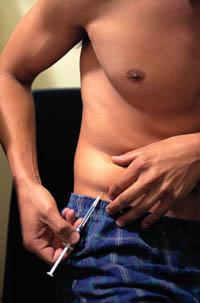New breathing for diabetics

The area of the patient with type 1 or juvenile diabetes does not work properly and is not able to produce insulin, so it is essential to receive insulin if they do not want blood glucose levels to increase too much. When calculating daily insulin doses, physical exercise and type of work should be taken into account, which is an extreme dependence on the patient.
Jay Skyler of the University of Miami and his team investigate 73 patients with type 1 diabetes. These patients were divided into two groups. The control groups followed the usual treatment and the rest only received an insulin injection at bedtime. In addition, the latter included the dose before meals during the day by air.
All patients were given blood glucose four times a day. In 12 weeks, the results of the measurement of glycosylated hemoglobin (HbA1c) were the same in both groups. This test, common in the control of diabetes, is the most suitable to assess the results of the three months of research.
In addition, other aspects such as the frequency and severity of hypoglycemia cases, the level of glucose in the blood after eating and eating, and lung function did not detect significant differences. The technique is already developed, has generated great expectation and only need to try with more patients to make it available to everyone.
Also suitable for type 2 diabetes
In addition, a new work on this topic has recently been published in the medical journal Annals of Internal Medicine. It shows the favors of respiratory insulin to diabetics, but unlike the previous, this time the patient had type 2 diabetes, that is, the most frequent type of diabetes.

Type 2 diabetes appears in older people and although their area is able to produce insulin, the body does not use it properly. In some cases it is enough to follow a proper diet to regulate blood glucose levels. Others, on the other hand, like type 1 diabetics, have to take insulin injections, with which the study was conducted. The effect of respiratory insulin was investigated in 26 patients. The method used was similar to that of Jay Skyler and the results obtained, since after three months of treatment, the glucose level was adequate.
Other options investigated
Larruzalpe XX injections. They have been used in the treatment of diabetes since the 1920s. Despite the numerous attempts made in the formulation of insulin, and the numerous attempts made by methods to avoid injections, they have not achieved a similar success to the current one. For example, oral insulin is divided into peptides by action of digestive enzymes, losing effectiveness.
In addition, other ways investigated for insulin administration are nasal inhalation and passage through the skin. However, insulin molecules are relatively large and make it difficult to use. In order for this to be possible, an aid would have to be used, but that generates health problems.
However, pulmonary alveoli have a high permeability and according to these latest studies no respiratory or pulmonary problems have occurred. All patients underwent spirometry, lung volume, oxygen saturation, etc. to show that there was no damage to respiratory function.
Although these studies are still recent, the results are encouraging for diabetics, since the administration of insulin doses using an aerosol would greatly facilitate daily life.
Buletina
Bidali zure helbide elektronikoa eta jaso asteroko buletina zure sarrera-ontzian











